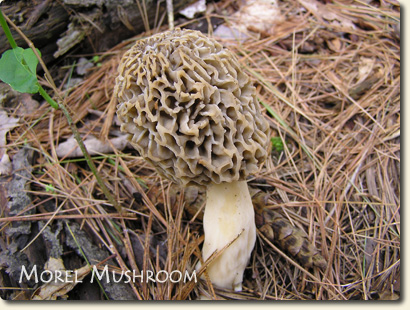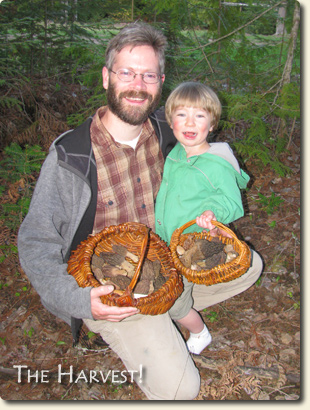Encountering Edible Wild Mushrooms
In this article, you'll learn all about foraging for edible wild mushrooms - benefits, hazards, identification techniques, harvest approaches and processing tips! It's exciting to know that by the time you get to the end of this article, you will have some great nuggets for learning about these tasty treats - almost as good as the mushrooms themselves!

Benefits of edible wild mushrooms
Wild edible mushrooms are clandestine treasures giving you the incredible pleasure of finding something marvelous right upon the forest floor. These fascinating fungi give us the opportunity to discover beauty and experience the landscape in a new way. They summon us to open up our senses and be filled by the smell of rain, be drenched in the moisture of mossy forests and they beckon us to inevitably taste their rich flavors.
Their distinct form offers us the opportunity to experience symbiotic mystery for they help keep plants alive, exchange nutrients with them, and help break down wood in the forest. Lastly, it's just plain fun to go mushroom hunting! There's a precious bond that forms between you, the mushrooms, and nature as well as with you and the ones you're with when you're out harvesting.
Edible wild mushrooms contain a host of vitamins and minerals, which promotes healthy skin, ensures your digestion to go smoothly and helps your nerves, muscles and heart to function well. I'm just scratching the surface here but I'd like to add that there are mushrooms that contain nutrients that even protect you against some cancers! I'm sold!
Safety First! Identifying poisonous mushrooms
Throughout North America 90% of mushroom poisoning is caused by the Amanita mushroom species. Therefore the Amanita mushrooms as well as the gilled Agarics are the first poisonous groups of mushrooms I recommend you learn closely. It will be a good starting point for learning the other poisonous mushrooms that grow in your area. Learn about the ones that can harm or kill you first!
Identification is important before we ever start harvesting anything to actually eat. This article includes a list of the top 10 most common edible wild mushroom groups in North America to help you in identification. Investing a lot of time up front in observation, research and identification will give you great rewards later in harvesting.
Only eat mushrooms that you have clearly identified. This means the mushroom needs to have all the identification marks that you see in the field guide. Make sure you are really looking at the mushroom when you're picking it. When in doubt, don't pick it. It's not worth it. If you are new to identifying and gathering mushrooms, I recommend going out with an experienced harvester the first time.
Get a mushroom field guide and pour through the anatomy section for understanding these different parts and identifying them on the mushrooms you find. I highly recommend checking out our article Identifying Wild Mushrooms which focuses on simple mushroom identification!
How to harvest wild edible mushrooms
There's a lot of debate about how to properly gather edible wild mushrooms. Some say to lever them up with your knife and take the whole mushroom while others advise to cut them with a knife close to the ground and leave the stalks. The principle to understand here is that you want spores to be left behind and not to be taken with you to help ensure reproduction next season.
Ethical harvesting means giving the mushrooms the opportunity for spore production in the future. For some mushrooms it can take up to 10 days for spores to drop after they have popped up. Many foragers use the term "rule of thumb" which means if it's smaller than your thumb, don't pick it. Given that there are so many variables involved in mushroom growth and reproduction, I suggest going to the lowest common denominator and never uproot the full mushroom when you gather. As well, do not over-harvest and mindfully leave a portion of mushrooms unpicked.
Harvesting edible wild mushrooms is like picking any other kind of delicate fruit or berry; they need to be carefully gathered so that we minimize our disturbance in their environment. This is one of the best ways we can show our gratitude and respect for the mushrooms and all the other life present there. When you're gathering, I suggest you cut the mushroom instead of pulling it from the ground and cover the area with a 1/2 inch of leaf litter where you've gathered once you're done. This gives the cut stalks a duff or debris layer once their fruit bodies are gone.
Pick and gather mushrooms when in good quality, not when they are soggy, wilted or mushy. Gather at most 10% of the amount you are seeing. Use discernment rather than your stomach to guide you when gathering wild edible mushrooms. Gather them in a woven basket or a linen bag instead of a plastic bag. Mushrooms can get sweaty in plastic and need air to breathe. Don't we all!
These mushrooms took a long time to grow. They need just the right weather conditions to grow before you finally see their final ripe form pop up. Depending on the mushroom, it can take several days to several weeks to grow. Be present to all that they offer you, from fascination to food.

Processing and preparations
Once you've gathered your mushrooms you need to clean them. Handle them with tender loving care. Wipe them with a damp paper towel or wash cloth. Cut off soggy parts and remove any critters. Some folks like to soak them in salt water to kill any small insects.
The process is that simple.
The preparation depends on how you want to enjoy these edible delights. If it's frying them in a little bit of oil, then cut or dice your mushrooms up into bite size pieces before cooking them in the skillet. You can bake them with oil, herbs, or spices and not cut them up at all. If you'd like to dry them, slice them up about 1/4 inch thick, then lay them flat on screens or on a food dehydrator tray to dry. Recipes can have more elaborate preparations. To help support your mushroom feast, we offer you a simple and classic complimentary recipe that will bring out the best in the wild edible mushrooms you gather!
Edible Wild Mushrooms Panfry
A recipe from the Twin Eagles kitchen
Ingredients:
- 2 – 3 tbsp. oil
- 3 - 4 green onions, finely chopped
- 1/4 small onion, chopped
- 5 cups edible mushrooms
- 1 1/2 tsp. spices (ex. salt, pepper, thyme, parsley, oregano)
Directions:
Heat oil in skillet. Add onions and sauté until translucent. Add mushrooms and spices and cook until liquid has disappeared. Serves 2 to 4.
Other uses of mushrooms
There are many other wonderful ways to interact with mushrooms besides eating them. For example, you can use them to carry an ember, make paper & fabric, or use them to dye textiles! The dyes produce incredible colors. Pungent reds, smoky greys, midnight blacks and brilliant yellows bring a special quality of mushrooms to life! After mentoring one of my students in the identification of mushrooms she later gifted me with a stormy blue silk scarf she dyed with mushrooms. What a treasure.
Top 10 groups of edible wild mushrooms in North America
- Boletes
- Morels
- Chanterelles
- Teeth Fungi
- Coral Fungi
- Club Fungi
- Milk Caps
- Russulas
- Light-spored gilled mushrooms with a ring
- Light-spored gilled mushrooms without a ring
Resources to continue the journey
Here are some books we recommend as you continue to learn about mushrooms. These are great resources for learning identification of poisonous and wild edible mushrooms, amazing stories about them, and recipes for cooking up fantastic fungal feasts!
- Edible Wild Mushrooms of North America By David Fischer and Alan Bessette
- Mushrooms Demystified By David Arora
- Mushrooming without Fear by Alexander Schwab
- National Audubon Society Field Guide to North American Mushrooms By Gary Lincoff
- Peterson Field Guide to Mushrooms by Vera and Kent McKnight
- Peterson Field Guide to Venomous Animals and Poisonous Plants by Steven Foster, Roger Caras, and Roger Tory Peterson
Please note that we are of course not responsible for any harm or accidents that may be caused from eating any mushrooms that are inedible. We strongly recommend you be able to 100% confidently identify all mushrooms before eating them.
There is so much in store for you just waiting upon the forest floor. Connecting with nature is a lifelong journey and the mushrooms teach us that deliberate and persistent growth is a profound way of cultivating that connection. In fact, the mushrooms themselves invite us to connect with them in the very way they grow up and out from the earth catching our attention.
Interested in being personally mentored in Edible Wild Plants, on a transformational journey of connection to nature, community, and self?
Check out the Twin Eagles Wilderness Immersion Program.
comments powered by Disqus
Return from Edible Wild Mushrooms to Edible Wild Plants
Return from Edible Wild Mushrooms to Wilderness Survival (homepage)
Track Us